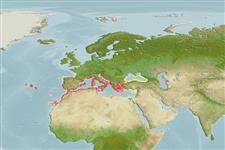Teleostei (teleosts) >
Blenniiformes (Blennies) >
Blenniidae (Combtooth blennies) > Salariinae
Etymology: Parablennius: Greek, para = the side of + Greek, blennios = mucus (Ref. 45335).
Environment: milieu / climate zone / depth range / distribution range
Ecology
Marine; demersal; depth range 0 - 2 m (Ref. 5298). Subtropical; 47°N - 2°N, 19°W - 42°E
Eastern Atlantic and Mediterranean Sea: Madeira, the Canary Islands and Victoria, Cameroon, off Iberian Peninsula to all parts of the Mediterranean including Morocco, the Sea of Marmara, and Black Sea (Ref. 5981).
Size / Weight / Age
Maturity: Lm ? range ? - ? cm
Max length : 8.0 cm TL male/unsexed; (Ref. 50932)
Facultative air-breathing in the genus (Ref. 126274); Adults inhabit rocky shores of coastal waters (Ref. 5298). Omnivorous (Ref. 94105). They feed on bottom invertebrates, especially gammarids; also feeds on algae (Ref. 5981). Oviparous. Eggs are demersal and adhesive (Ref. 205), and are attached to the substrate via a filamentous, adhesive pad or pedestal (Ref. 94114). Larvae are planktonic, often found in shallow, coastal waters (Ref. 94114).
Life cycle and mating behavior
Maturity | Reproduction | Spawning | Eggs | Fecundity | Larvae
Oviparous, distinct pairing (Ref. 205).
Bath, H., 1990. Blenniidae. p. 905-915. In J.C. Quero, J.C. Hureau, C. Karrer, A. Post and L. Saldanha (eds.) Check-list of the fishes of the eastern tropical Atlantic (CLOFETA). JNICT, Lisbon; SEI, Paris; and UNESCO, Paris. Vol. 2. (Ref. 5298)
IUCN Red List Status (Ref. 130435: Version 2024-1)
Threat to humans
Harmless
Human uses
Tools
Special reports
Download XML
Internet sources
Estimates based on models
Preferred temperature (Ref.
123201): 17.1 - 21.2, mean 18.9 °C (based on 449 cells).
Phylogenetic diversity index (Ref.
82804): PD
50 = 0.5000 [Uniqueness, from 0.5 = low to 2.0 = high].
Bayesian length-weight: a=0.01096 (0.00588 - 0.02044), b=3.00 (2.84 - 3.16), in cm total length, based on LWR estimates for this species & Genus-body shape (Ref.
93245).
Trophic level (Ref.
69278): 2.7 ±0.1 se; based on diet studies.
Resilience (Ref.
120179): High, minimum population doubling time less than 15 months (Preliminary K or Fecundity.).
Fishing Vulnerability (Ref.
59153): Low vulnerability (10 of 100).
Nutrients (Ref.
124155): Calcium = 333 [153, 795] mg/100g; Iron = 1.81 [1.03, 3.51] mg/100g; Protein = 18.7 [17.5, 19.8] %; Omega3 = 0.293 [0.148, 0.581] g/100g; Selenium = 9.43 [4.47, 22.49] μg/100g; VitaminA = 23.5 [6.6, 83.7] μg/100g; Zinc = 1.72 [1.10, 2.68] mg/100g (wet weight);
